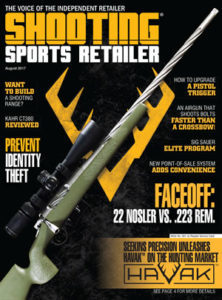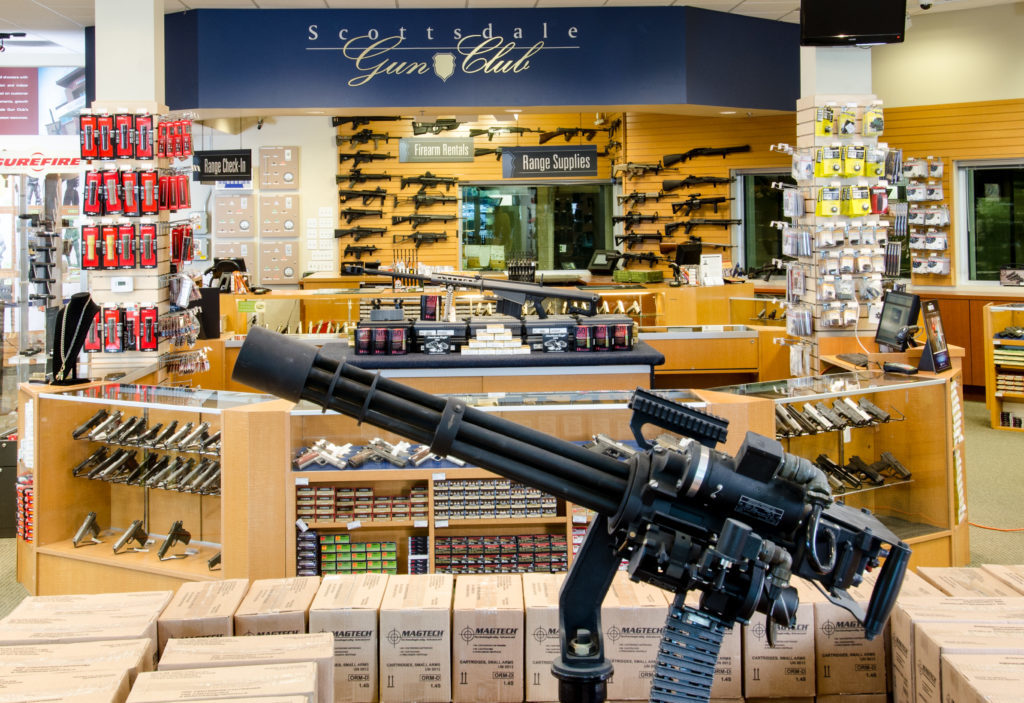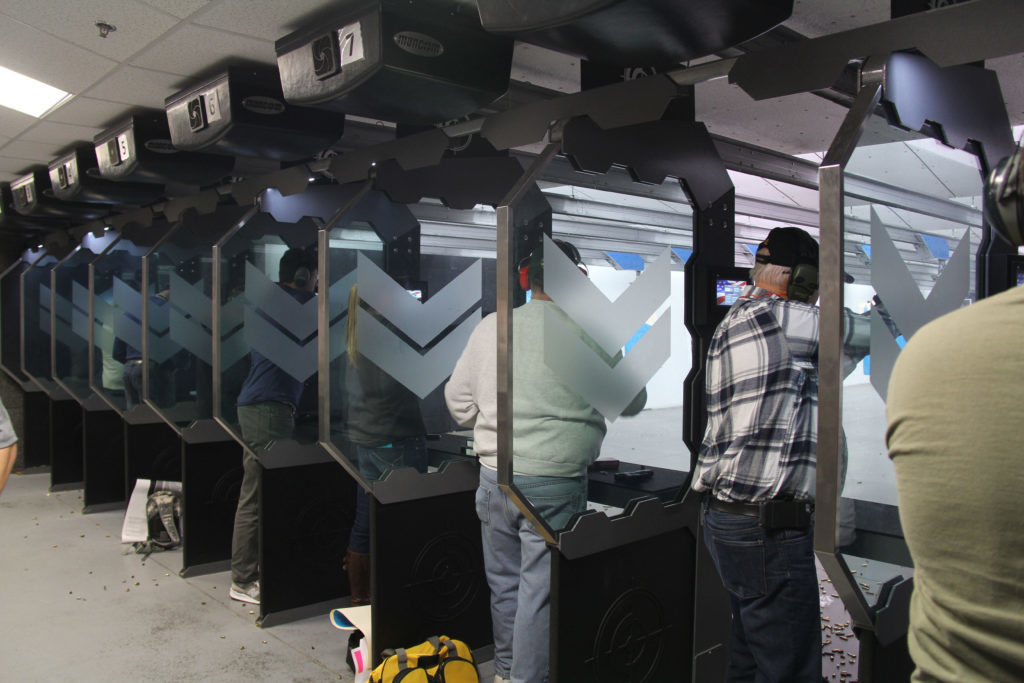Margins are small in the retail gun business. Although new shooters are discovering the fun and rewards of shooting, and are therefore spending money on guns and equipment, gun retailers still must contend with low mark-ups on the sale of guns. Reducing business expenses can go only so far to increase profits, so with low margins, the solution often is to increase sales volume. But how?
A trend has developed in recent years. Some retailers have found that by adding a shooting range to the retail operation, more customers are attracted to the store, which results in more sales of everything from guns and ammunition to other accessories needed to enjoy shooting.
The first large indoor shooting range and retail operation of its kind with many upscale amenities was reportedly a private, member-only range and lounge called the Scottsdale Gun Club. Located in Scottsdale, Arizona, it is located alongside a public range and was completed and opened for business in 2004. The owner and CEO, Terry Schmidt, is arguably responsible for creating an industry that has spawned upscale retail shops with indoor shooting ranges throughout the country. Thirteen years later, the Scottsdale Gun Club is a highly successful, thriving operation. But making it a reality was tough.

From our August issue
Resistance came from a small minority of citizens that were against guns in general. They were able to negatively influence politicians and government officials responsible for approving plans. Additionally, a number of hurdles involving government agencies like the United State Environmental Protection Agency (EPA), Occupational Safety and Health Administration (OSHA) and Bureau of Alcohol, Tobacco, Firearms and Explosives (ATF) had to be overcome. State and local government requirements involving engineering standards, drainage, lead abatement and containment, signage and other issues had to be complied with. Permits were slow coming even after two years of work. Finally, government permits and approvals were secured, but obtaining institutional financing became a problem because of a general prejudice against the gun business. Eventually, a blend of private and institutional financing was secured and the project moved forward. But the story illustrates the type of obstacles that could be encountered by other entrepreneurs anywhere in the country.
Because of successful ventures like the Scottsdale Gun Club, more ranges today are being built. But the potential pitfalls are still formidable. The retailer considering building a brand-new range needs to do a great deal of research before making a commitment to the hard work that is building a range.
Schmidt is clear about the need for sound research and planning before a retailer — or anyone else — decides to build a retail/shooting complex. “You’ve got to make sure the project is planned well and that you’re in the right location,” says Schmidt. And to do that, he says, “Spend the money to get a competent accountant or consultant to analyze the idea, determine how long it will take to turn a profit, estimate the size of debt service and add up the increase in expenses over a retail operation. It will be well worth the consultant fee.”
He didn’t stop there. “My recommendation for a retailer thinking about starting a range is to make sure they understand their budget, what they are stepping into, and their rate of return.” Otherwise, they could easily fail — as many do. He also cautioned that market oversaturation is a major concern. Any given market can support only a certain number of shops and ranges. Adding too many can lead to failure and hurts all the retailers and ranges in the area.
Joe Keffer, the owner of The Sportsman’s Shop in East Earl, Pennsylvania, purchased an established retail gun store in 1992. As time passed, he saw changes in the market and decided the needed to offer more than a traditional gun shop to survive in the industry. So he purchased an old bowling alley, converted it to a retail store and shooting range and opened for business in July 2015. “Looking back, it was a good decision,” he said. Without giving a figure, he did indicate the range addition has resulted in a dramatic increase in retail sales.
The decision was not made overnight. Keffer did a lot of research before committing. “The first consideration is, what is the competition now and what will it be like two, five and 10 years down road,” he said. Keffer is an experienced gun store owner and did his own research before deciding to build a range. He also used information provided to members by the National Shooting Sports Foundation (NSSF).

The large, well-lit showroom at Scottsdale Gun Club displays a massive selection of guns, ammunition and accessories. (Credit: SGC)
Taylor Hayden, owner of Blackstone Shooting Sports in Charlotte, North Carolina, expressed the value of a membership in NSSF. According to Hayden, the NSSF has a great deal of good information available to members and “they don’t sugar coat it.” Getting a marketing study from the NSSF is “a good way to go,” he said, because it contains valuable information about the potential risks and all of the complexities involved in building a shooting range.
“(Building a range) is going to be way more expensive than they think it is,” Hayden said. He explained from his experience that he consults for people who want to build a range and points out that most do not begin construction because of the capital requirements and the work involved.
“Everyone throws different figures around about the cost of ranges, but the ones on cost per lane that the NSSF puts out are fairly accurate,” Keffer said. No source interviewed for this story would cite a current dollar amount spent on the construction of a retail store and shooting range, but it is safe to say cost can easily be millions of dollars depending on the size and complexity of the operation.
According to Zach Snow, Director Shooting Range Services for the NSSF, the per lane cost of building an indoor shooting range “really depends on what type of system you go with — steel trap versus rubber trap — the technologies within your target retrieval system — non- or fully climate controlled ventilation system — and whether you’re including the ventilation costs in the per lane expense. A low-ball number per lane is probably $35,000, and a high-ball figure would be about $60,000 per lane.”
Good ventilation is expensive. The quality of air released from inside the range to the outside as well as the quality of air shooters are exposed to is a major concern. Lead abatement is particularly important given fine particles of lead can be released into the air when a gun is fired. To combat this, high-quality filter systems are incorporated into the heating, ventilation and air conditioning (HVAC) systems and increase the cost of an already-expensive building component.
Target retrieval systems can also be simple or very expensive and complex. They can be not much more than cables running down range with clips to hold targets, to elaborate and programmable systems that move the targets up or down range and rotate them at different intervals. Then there are barriers between the shooting positions to protect shooters from unintentional discharges from other shooters. These also vary in cost and can be simple steel partitions or bullet-resistant glass.

Customers can buy guns and equipment in the retail shop, then enjoy shooting at Backstone's modern indoor range. (Credit: Blackstone)
The math is simple. Using Snow’s numbers, 16 or 17 lanes with the best equipment will cost about $1 million. Add more lanes, plus everything that goes into a retail operation, and getting to eight figures is not difficult.
So, it is clear that the retailer considering adding a shooting range needs to research the idea and consider carefully all the expenses and risks. Experienced help is available to NSSF members. This includes annual firearm retail surveys, shooting range surveys and industry financial reports on firearms retailers.
“The first step [in the decision making process] is getting a good understanding of the potential market within the area. NSSF has a resource known as the Customized Market Report that provides a lot of demographic information including household trends, effective buying incomes, area target shooters and competition,” Snow said. Information can be used in writing a business plan, which is important when seeking loans. “Many of our members have sworn that the report is key to getting a loan from a local bank,” Snow said.
NSSF can also introduce members to independent consultants who can help with everything from evaluating the data collected about market conditions, to creating pro forma financial documents and assistance with creating a business plan. They can also help with building design and construction. Fees are negotiated between the member and the consultant, but regular NSSF members are eligible for $1,000 to $1,500 financial assistance for consulting fees. Premium members may get up to $5,000 assistance.
Snow agrees with Schmidt and Hayden that not all range operations are successful. Some do not even get started, and retailers should be aware that building a range is not a get-rich-quick opportunity. It requires many 40-plus-hour weeks, and the owner may not be able to draw a salary for a couple of years.
“Existing retailers seem to have a better chance of success because of their experience in the retail firearms business,” Snow said. He added, “By incorporating the range into the retail business, firearm sales increase plus the retailer benefits from range revenue.”
Lastly, and importantly noted by Keffer: “Do your homework.
Feature image: SGC




